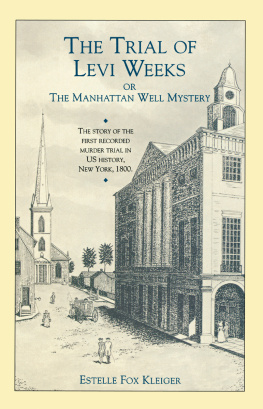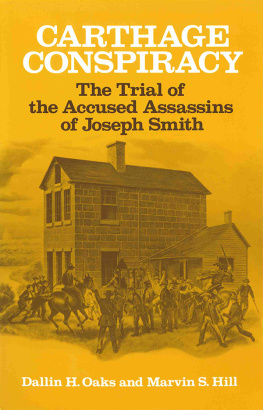For Miriam and Richard and Marjorie and Bea and Sarah and Aaron
Published by
Academy Chicago Publishers
363 West Erie Street
Chicago, Illinois 60610
Published in 1989
First paperback edition 2001
1989 by Estelle Fox Kleiger
Printed and bound in the U.S.A.
No part of this book may be reproduced in any form without the express written permission of the publisher.
Library of Congress Cataloging-in-Publication Data
Kleiger, Estelle
The trial of Levi Weeks / by Estelle Kleiger.
p. cm.
Bibliography: p.
ISBN 0-89733-492-2
1. Weeks, LeviTrials, litigation, etc. 2. Trials (Murder)New York (N.Y.) I. Title.
KF223.W44K59 1989
345.73 02523dcl9
[347.3052523]
87-37370
CIP
A CKNOWLEDGMENTS
My thanks to many New York City and Westchester librarians for assistance in ferreting out the material in these pages. Access to the wonderful collection of documents at the New-York Historical Society Library was achieved through the efforts of Marion Touba and Mary Cary, among many others. Westchester Countys excellent library and information system made it possible for me to discover where in the county I might obtain certain works. It also gave me the privilege of working at Westchester college and university libraries. I am very grateful for the help of Janet Dempsey, Cornwall Town Historian, and Elizabeth H. Moger, Keeper of the Records at the Haviland Records Room. Special thanks go to Miriam L. Kleiger and Beatrice Fox for their help.
I would also like to thank Anita Miller for her editorial guidance, and Jane Kohen Winter of Academy Chicago Publishers who, on a trip to Natchez, Mississippi, discovered Levi Weekss second life and who helped pull it all together, and the following Mississippians for contributing to the Natchez section of the book: Hunter Cole of the University Press of Mississippi; Hank Holmes and Michael Hennen of the Mississippi Department of Archives and History; Ron Miller of the Natchez National Historical Park Foundation; Edna Joseph of the Auburn Garden Club; Kathy Wesley of the Judge George W. Armstrong Library; David Gleason, photographer; Ronnie James; Sara McGehee; and the women who run Stanton Hall.
C ONTENTS
Index
C HAPTER O NE
THE DISAPPEARANCE
On Sunday, December 22, 1799, shortly after eight oclock in the evening, a young woman named Gulielma Sands left the boardinghouse where she lived on Greenwich Street in New York City; she was never to return alive. After a day or so, when it became apparent that Elma, as she was called, had not spent the night with friends, Catherine and Elias Ring, who owned the boarding-house, became apprehensive about her welfare. A search was mounted for Elma; as the days passed apprehension turned to dread.
A week after her disappearance, some boys playing in Lispenard Meadows found Elmas borrowed muff floating in the Manhattan Wellso called because it had been dug by Aaron Burrs Manhattan Company. The Well was probed and Elmas bruised and sodden body was fished from its depths.
Catherine Ring was Elmas cousin; she and her husband Elias were Quakers. They lived with their four children and Catherines sister, Hope Sands, in the boardinghouse at 208 Greenwich Street; Elma had been with them for three years. The New York City Directory for 1798 lists Elias Ring as having a dry goods store at that address. In those days, when there were no defined shopping areas in the city, merchants frequently ran businesses in their homes. In fact, Catherine Ring ran a millinery shop at 208 Greenwich Street; it was a good-sized enterprise which employed as many as twenty young women, including Elma Sands. At the neighboring house on one side of the Rings, Lorena and David Forrest lived and sold tobacco. On the other side was the house of Joseph Watkins, an ironmonger. Watkins house furnishing store and nail factory was a well-known and thriving establishment.
In 1776, while the British occupied New York, fire destroyed 1,000 buildings; in 1778 there was another disastrous conflagration. Because of this and because the population of the city was growing rapidlyit was 30,000 in 1789 and 60,000 ten years laterthere was a housing shortage. Newcomers to the city, whatever their class and financial situation, usually stayed in boardinghouses until they could find permanent housing. In 1789 there were said to be 330 boardinghouses in New York City, many of them quite elegant, but all of them filled to capacity.
At the time of Elmas disappearance there were five boarders unrelated to the Rings at the Ring house, and a lodger who did not take his meals there. One boarder was a young woman named Margaret Clark; the others were men, among them a young carpenter named Levi Weeks who shared his room with his apprentice. On the Sunday evening she disappeared, Elma had confided to Catherine Ring that she and Levi Weeks were to be secretly married that night. Thus suspicion immediately fell on Levi Weeks.
On January 4, 1800, the New York Daily Advertiser printed the story:
Although the newspaper was filled with details of national mourning for George Washington, who had died on December 14, 1799, this item attracted a good deal of attention. It was the nature of this crime that upset the citizens; the city of New York, with a population in 1800 of 60,515, was not free from random murder. A period of lawlessness had followed the Revolution and the watch had been increased: no protection was provided during the day, but at ten oclock each night the watchman collected his lantern, stick, rattle and badge, and started on his rounds wearing his leathern hat which had earned him the nickname of leather head. These men often dozed off in their watchboxes, because most of them had to work full-time jobs during the day to augment their skimpy salaries. There is a story about the young Washington Irving and his friends throwing a rope around an occupied watchbox and towing it down the street while the rudely awakened watchman protested loudly from inside it.
The number of crimes is greater in the city of New York than elsewhere in the state, wrote a European in 1784 the Mayor had recommended to the grand jury that something should be done about riots and disorder in Canvas-town, and in 1800 the area was still festering.
In the center of the city, on the site of the present City Hall, stood the gallows, designed for some reason to resemble a Chinese pagoda, and stocks and whipping posts were nearby. On the frequent occasions when these devices were put to use, spectators flocked to cheer or jeer or simply to watch. There were times when as many as six criminals were hanged in one day. They were not all accused of murder: until 1796 hanging crimes included first offense burglary, arson, housebreaking and forgery. The theft of the most trifling article could bring thirty-nine lashes on the bare back. Women as well as men were subject to this punishment: one Sarah Crowdy is recorded to have received twenty lashes for petty larceny. After 1796 there was some penal reform, and the death penalty was limited to treason, murder and theft from churches. Flogging however was retained, left to the discretion of the court.
So crime was not a rarity in the city, and neither was violence: the upper classes committed their special violence against each other through duelling, which was illegal but very much a part of the social code, because only gentlemen duelled. The conviction of a duellist in a court of law was virtually unheard-of, and anyone Hamiltons son was killed in a duel. In 1804 Hamilton himself was challenged by Aaron Burr over a newspaper report that Hamilton had slandered Burr at a dinner party. Hamilton attempted to placate Burr by saying that his remarks had been in reference to political topics only, but Burr, unassuaged, had then demanded to know whether Hamilton had ever spread rumors that reflected on the Colonels honor.
Next page









